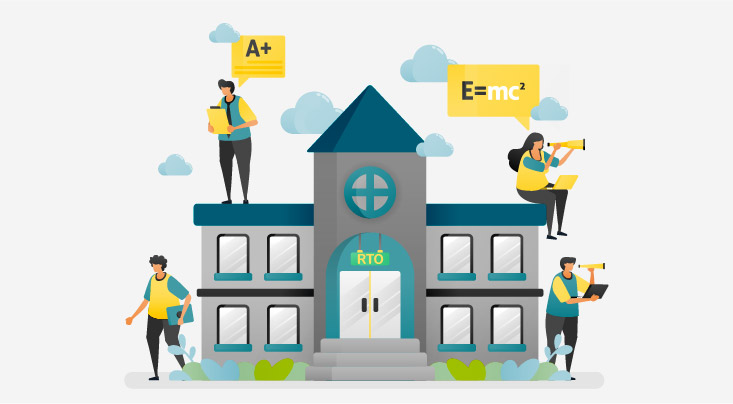
2024 Changes to Skills First
Taking into account RTO’s need for certainty, the Department has offered a Skills First contract of 2-years duration. The longer-duration

Setting up your own Registered Training Organisation (RTO) is not a simple process and comes with an enormous amount of hard work, risk and cost. Whether you decide to go it alone or engage a consultant to assist with the process, there is a lot that you should consider prior to making that decision. In this article, we try to explain the registration process for a national domestic RTO and provide you with advice that will hopefully assist you with making the right decisions.
The registration process follows these general steps:
Stage 1 – Desktop Audit – this will focus on reviewing the following:
Stage 2 – Validation – this is typically an on site audit but could be conducted via email, phone, zoom or similar. It focuses on validating that you are ready to deliver quality training and assessment.
Successful applications will be granted a 2-year initial registration. There are restrictions placed on your organisation during this period including your ability to add to scope.
We recommend starting the whole process with your business strategy. How you intend to operate your business in the short term and how you intend to grow your business into the future, will be a deciding factor in ASQA’s decision to approve your registration status. The following steps act as a suggestion for how you should prepare for such an application.

Two things to consider here in terms of true cost –one is obviously the financial costs and the other is the time cost. There is no denying that the application process takes a serious amount of time and you should consider what other revenue-generating activities that this process takes you away from. You will need to find a healthy balance and manage your own expectations with respect to the progression of your application. As a rough guide, here are some cost considerations for you:
| Off the Shelf Policies & Procedures, forms, registers and templates | $5000 to $15,000 |
| Student Management System | $1000 to $3000 (entry level) |
| Learning Management System | $1000 to $3000 (entry level) |
| Training related materials including assessments | $10,000 to $15,000 (based on average of 3 quals) |
| Training equipment (for practical based qualifications, etc.) | $5,000 to $15,000 |
| Accountant Fees for FVRA | $2,500 to $5,000 |
| ASQA application lodgement fee | $500 |
| ASQA application assessment fee | $8,000 |
| Legal costs (associated with employment contracts, etc.) | $5,000 |
| Company registration (ASIC fees, trading names, etc.) | $1,000 |
| Website Build | $3,000 to $10,000 |
| Insurances | $3,000 to $5,000 |
| Facilities (office space, training rooms, etc.) | unknown |
| Consultancy Fees | unknown |
| TOTAL | $45,000 to $85,000 |
The business strategy document starts the conversation with ASQA about becoming a Registered Training Organisation. It provides a justification to why you should be an RTO and outlines how you will maintain yourself as a going concern. It identifies your core market, your core service offerings and explains your operational structure. Without a sound strategy and operational plan, there is no point in commencing work on training resources and policies and procedures. At a minimum, this document should address the following:
It is critical that this document supports the financial viability spreadsheet and the two documents should support (and not contradict) each other.
You will need the input of a qualified accountant to help prepare and sign off on your financial viability risk assessment (you need to provide an accountant’s certificate as supporting evidence). Quite often, organisations go to their trusted accountant to complete this document and more often than not, the accountant does not complete the spreadsheet properly.
The FVRA tool, accompanied with supporting evidence provides ASQA with the current position, performance, and projection of your organisation’s finances. The type of evidence required to support the submission includes the business strategy document, bank statements, annual financial reports, management accounts, tax compliance records, aged creditor and debtor statements, bank reconciliations, details on the intended qualifications and courses offered by your organisation, projected student enrolments, itemised staff numbers and associated costs and an independent attestation of compliance from a qualified accountant.
ASQA will use this information to make a determination of the financial health of your business paying specific attention to your ability to have enough liquidity to manage cashflow and outgoings, compliance with tax obligations, demonstration of financial management, accuracy and integrity of the forecast projections including the underlying assumptions based on the aspirations and strategic direction of the RTO.
Understanding this in advance allows you to plan adequately for a submission. In preparation, ask yourself a couple of critical questions:
Given the weight that this document holds with ASQA, it is extremely important that you contribute to the population of the FVRA tool – you are running your business and therefore should be contributing to the forecasted revenue and expenditure tabs as a minimum. In addition to this, you should also ensure that your business strategy ties in to the FVRA (and vice versa). Organisations often contradict themselves by saying they will do one thing in their business strategy, yet they tell a completely different operational story in their FVRA.
In our experience, most organisations fail FVRA because the business owner assumes their accountant will do what is required, but in actual fact, the FVRA says a lot about your operations and you should have significant input into this document.
Estimated Cost: $5,000
If you are a start-up, you will need to consider the time and cost of creating your branding and web presence. A website that demonstrates compliance with the Standards is critical along with any associated marketing materials like course information brochures. You can get away with a basic website for around $3000-$4000 but you should consider the cost of branding including colour palette, logo design, business cards, etc.

You will also need to set up accounts for any social media platforms that you plan on using including Facebook, Instagram, LinkedIn, Twitter, etc. All publicly available information should be designed and presented to meet the standards.
Estimated cost: $4,000 to $8,000
Your policies and procedures need to do two things; they need to address the Standards for RTOs 2015 and they also need to be contextualised to your organisation. If you are planning on writing your own set of policies, we recommend ensuring that you do the following:
Many consultants sell policy and procedure sets so if you are planning on purchasing off the shelf documentation, make sure you do some due diligence and remember, price SHOULD be an indicator of quality, but in this industry, IT IS NOT. Some considerations to make:
In this heavily regulated industry, an RTO could have as many as 100 different documents that cover policies and procedures, forms, templates, and registers, so be sure that what you are purchasing is everything that you need.
Estimated Time for Going it Alone: 2 months (full time)
Estimated Cost for Purchasing: $5,000 to $15,000
ASQA expects you to be ready to deliver training at the time of submitting your application, which means you will need an AVETMISS compliant student management system. There are two major considerations to make here; one is choosing the right system for the long term and the other is what costs are initially associated with implementing such a system.
There is no point implementing a student management system in the early stages of your RTO if it isn’t going to be capable of servicing your future needs. You should consider the following functionality:
You will need to balance the short term and long-term business requirements with the cost of implementing such a system. A web-based system with a tiered pricing model would work best as you can enter the SMS market with a lower tiered product and increase the functionality/modules as your business grows.  You should also consider the time your staff will spend learning the system and setting it up.
You should also consider the time your staff will spend learning the system and setting it up.
Estimated Cost: $200/month to begin with
We cannot stress enough how much scrutiny your training and assessment strategies (TAS) will come under. They are the centrepiece to your application. How you present your intended programs determines what trainers you recruit, what course materials you require, and what facilities you need to support the programs. Your TAS documents will be picked apart at audit and you should consider the following when creating a program:
Explain the delivery of the program including reference to volume of learning/amount of training, attendance requirements, expected duration, delivery structure (clustered, standalone, etc.) and assessment methods.
The big decision here for you to make is whether you are going to build your own course materials or purchase them from a resource company. There is an abundance of off the shelf resources available for purchase and you will need to spend some time reviewing the options out there. We strongly recommend conducting the following due diligence:
If you decide to go your own and write the course materials yourself, we would still advise having them externally reviewed. With these projects, its very easy to get too close to the work and sometimes it is difficult to see what’s missing.
You will need to ensure that you have built capability in your business prior to the assessment phase of your application. Auditors will want to talk directly with you about your knowledge of the industry and about your internal capabilities. Remember, that what you say in your business plan and what you represent in your financials need to reflect your actual org structure too.
Other considerations include your physical training facilities and office space requirements. You will need to submit lease agreements, office plans and potentially provide access to these as part of the audit. As we mentioned earlier, you need to be ready to train at the time of your application.
It depends. If you feel that you have the capability and time to go through the process yourself, then go for it as you will no doubt save money. Just make sure that you have the knowledge and time to allocate to the project.
If you decide that you need to engage a consultant for the process, consider asking the following questions:
Before you sign off on any contract with a consultant, you should make sure that you are crystal clear on who will actually do the work – you or the consultant. Quite often consultants will charge for the RTO Setup project but only in their capacity as a guide, reviewing evidence and providing feedback. Whilst this feedback can be extremely valuable, it may not achieve the desired outcome that you were looking for in the first place. You want to make sure you are clear about who does what – for example, who builds the TAS? Who creates the trainer docs? Who contextualises the policies and procedures?  All questions that should be answered prior to signing an agreement. We have spoken to a lot of frustrated organisations who signed up to a service expecting the consultant to do the work, only to realise that they were expected to do everything themselves.
All questions that should be answered prior to signing an agreement. We have spoken to a lot of frustrated organisations who signed up to a service expecting the consultant to do the work, only to realise that they were expected to do everything themselves.

Taking into account RTO’s need for certainty, the Department has offered a Skills First contract of 2-years duration. The longer-duration

Managing the transition from superseded training products can be a complicated and time-consuming process for RTOs. From time to time,

According to the Audit and Assurance Findings Report by the Department of Education, Evidence of Participation (EOP) made the top 5 most common issues identified at audit. Make sure you’re on top of your EOP obligations!

The 2023 Victorian VET Funding Contract came with significant changes to the eligibility settings. In this article, we cover the 2023 changes relating to the Skills First eligibility requirements and evidence retention.

In an effort “to increase the ability of Victorians to reskill and to continue to participate in an evolving economy”,

Not all Skills First funded training conducted in the workplace translates into an apprenticeship/traineeship enrolment. It is common for Training

